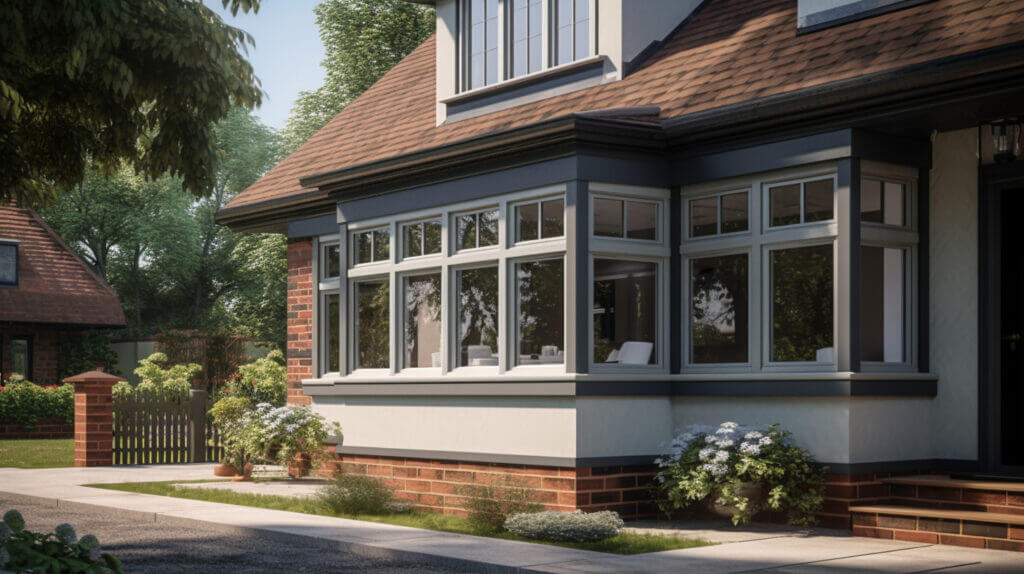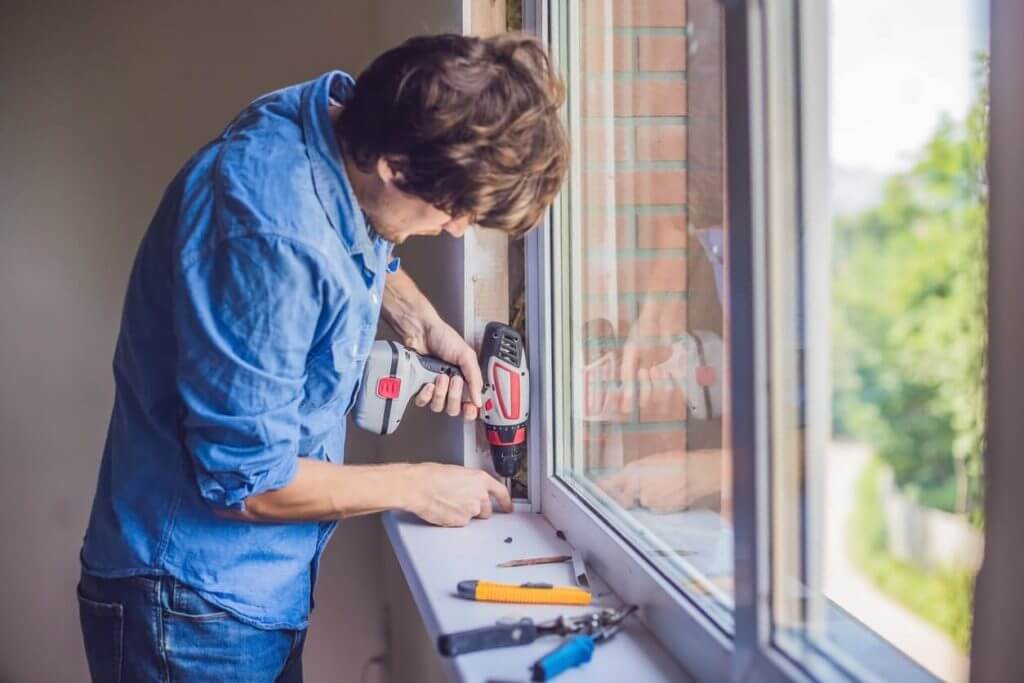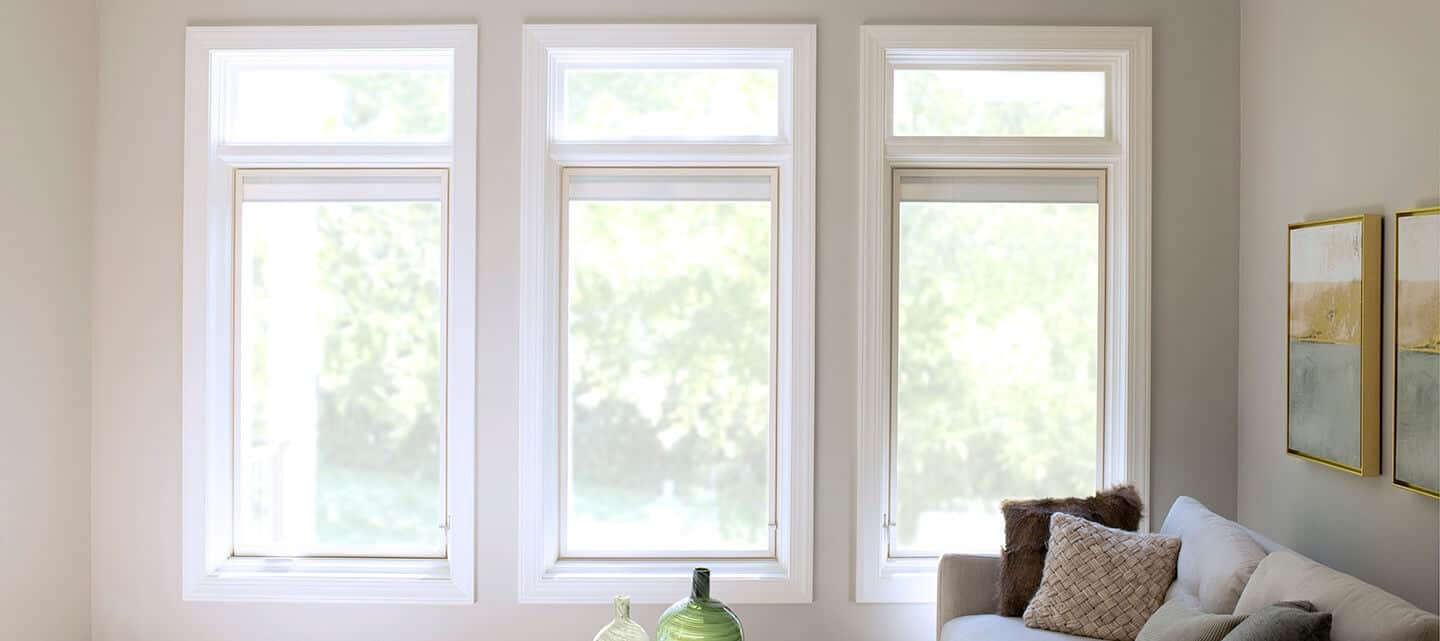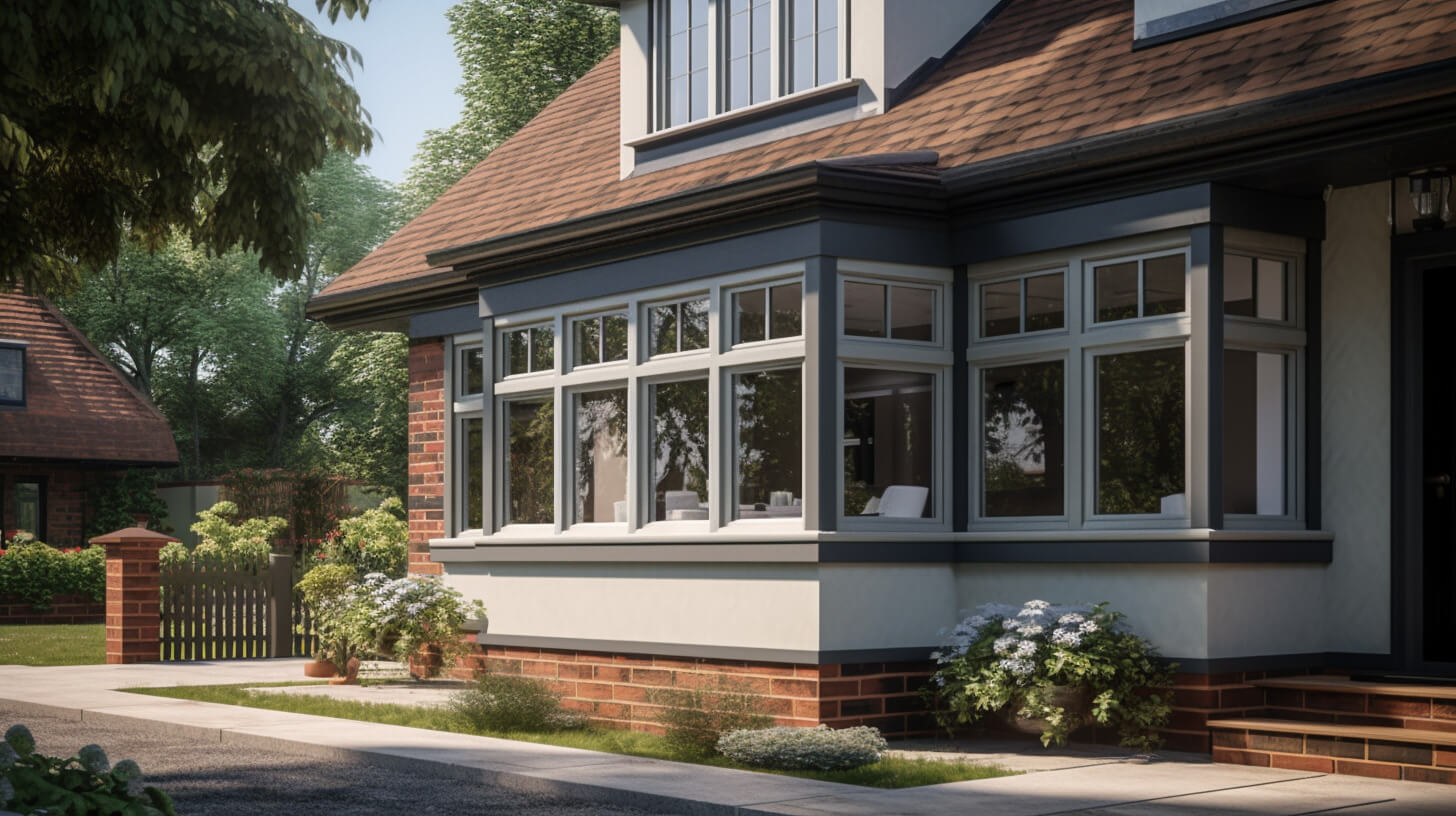- How Much Does Window Replacement Cost in 2025?
- National Average Window Replacement Cost
- Average Window Replacement Cost by State
- Cost per Window vs. Whole Home Window Replacement
- Factors Affecting Window Cost
- Window Replacement Cost by Frame Material
- Costs by Window Type
- Window Replacement Cost by Glass Type
- Costs by Window Brand
- Additional Costs and Considerations
- Should I Replace My Windows?
- How to Save Money on Replacement Windows
- Costs by Window Type
- Final Thoughts on Replacement Window Costs
- Frequently Asked Questions
How Much Does Window Replacement Cost in 2025?
Replacing your windows is one of the most valuable investments you can make in your home’s energy efficiency, resale value, and comfort. In 2025, the national average cost for window replacement is $1,047 per window. This is based on 1,061,338 real homeowner projects over the last 6 months with Modernize, and includes both material and labor costs. That price can fluctuate based on the type of window, the materials used, the size of your home, and where you live.
This guide breaks down everything you need to know about window replacement costs in 2025. You’ll find national averages, price factors, cost by window type, and a full 50-state breakdown to help you budget more accurately for your project.
National Average Window Replacement Cost
Based on 1,061,338 homeowner projects with Modernize, the national average window replacement cost is:
- National Average: $1,047 per window
- Material Cost: $897
- Labor Cost: $149
- Typical Range: $700 to $1,400 depending on size, features, and location
The average homeowner can expect to pay just over $1,000 per window for a full replacement, which includes the cost of the window unit itself and professional installation. Material makes up the bulk of that cost, often accounting for 85% or more of the total price, or $897 per window, while labor averages around 15% of the total cost, or $149 per window.

Home Window Replacement
Average Installation Cost $700 - $1,400
Cost Breakdown
- Materials 85.8%
- Labor 14.2%
Lower-cost options can fall under $700 for smaller or standard vinyl windows, especially in lower-cost regions, while custom, high-efficiency, or architectural windows can push the price north of $1,400.
This national average is based on aggregated data across urban, suburban, and rural areas, and is influenced by factors like window size, energy efficiency ratings, regional labor markets, and material availability. Keep in mind that this figure assumes full-service professional installation, not DIY or contractor-only pricing, and includes typical services such as removal and disposal of old windows, trim, sealing, and finish work.

Average Window Replacement Cost by State
Window replacement costs vary across the country due to differences in material pricing, labor rates, and regional regulations. Here’s a detailed per-window estimate — including materials and labor — for every state, based on real homeowner data in 2025:
| State | Total Average Cost | Material Cost | Labor Cost |
|---|---|---|---|
| AL | $974.90 | $835.96 | $138.94 |
| AK | $1,128.72 | $967.19 | $161.54 |
| AZ | $1,000.00 | $857.29 | $142.71 |
| AR | $924.85 | $793.28 | $131.57 |
| CA | $1,128.72 | $967.19 | $161.54 |
| CO | $1,026.11 | $880.97 | $145.14 |
| CT | $1,026.11 | $880.97 | $145.14 |
| DE | $1,026.11 | $880.97 | $145.14 |
| FL | $1,067.58 | $916.32 | $151.25 |
| GA | $1,000.00 | $857.29 | $142.71 |
| HI | $1,128.72 | $967.19 | $161.54 |
| ID | $942.25 | $807.10 | $135.15 |
| IL | $1,026.11 | $880.97 | $145.14 |
| IN | $924.85 | $793.28 | $131.57 |
| IA | $942.25 | $807.10 | $135.15 |
| KS | $942.25 | $807.10 | $135.15 |
| KY | $924.85 | $793.28 | $131.57 |
| LA | $942.25 | $807.10 | $135.15 |
| ME | $1,026.11 | $880.97 | $145.14 |
| MD | $1,026.11 | $880.97 | $145.14 |
| MA | $1,128.72 | $967.19 | $161.54 |
| MI | $1,000.00 | $857.29 | $142.71 |
| MN | $1,000.00 | $857.29 | $142.71 |
| MS | $924.85 | $793.28 | $131.57 |
| MO | $942.25 | $807.10 | $135.15 |
| MT | $942.25 | $807.10 | $135.15 |
| NE | $942.25 | $807.10 | $135.15 |
| NV | $1,000.00 | $857.29 | $142.71 |
| NH | $1,026.11 | $880.97 | $145.14 |
| NJ | $1,128.72 | $967.19 | $161.54 |
| NM | $942.25 | $807.10 | $135.15 |
| NY | $1,072.40 | $918.76 | $153.64 |
| NC | $1,000.00 | $857.29 | $142.71 |
| ND | $924.85 | $793.28 | $131.57 |
| OH | $1,000.00 | $857.29 | $142.71 |
| OK | $942.25 | $807.10 | $135.15 |
| OR | $1,026.11 | $880.97 | $145.14 |
| PA | $1,026.11 | $880.97 | $145.14 |
| RI | $1,026.11 | $880.97 | $145.14 |
| SC | $974.90 | $835.96 | $138.94 |
| SD | $924.85 | $793.28 | $131.57 |
| TN | $974.90 | $835.96 | $138.94 |
| TX | $1,001.75 | $859.72 | $142.02 |
| UT | $1,000.00 | $857.29 | $142.71 |
| VA | $1,026.11 | $880.97 | $145.14 |
| VT | $1,026.11 | $880.97 | $145.14 |
| WA | $1,026.11 | $880.97 | $145.14 |
| WI | $1,000.00 | $857.29 | $142.71 |
| WV | $924.85 | $793.28 | $131.57 |
| WY | $942.25 | $807.10 | $135.15 |
Cost per Window vs. Whole Home Window Replacement
For a typical 3-bedroom home with 10–15 windows, the total window replacement cost can range from $10,000 to $15,700+, depending on the types of windows selected, the materials used, and your region’s labor rates. This estimate includes both the cost of the window units themselves and professional installation, such as old window removal, trim work, and finishing.
Homeowners should keep in mind that full-home replacements may also offer opportunities for bulk pricing or promotional discounts. Contractors often reduce the per-window labor rate when several units are being replaced at once, which can significantly lower the total cost.
On the higher end of the range, premium window types (like bay or bow), high-efficiency glass, or installations in hard-to-access areas can increase costs well above $1,400 per window. On the lower end, choosing standard-size, vinyl-framed, single-hung windows in a region with lower labor costs can keep project totals much more affordable.
Factors Affecting Window Cost
Actual project costs depend on many factors, each playing a major role in determining your final quote:
- Window Style (or Window Type): The type of window you choose will impact the price. For example, double-hung windows — which slide both up and down — are the most popular in the U.S. and serve as a pricing baseline. Other styles like bay, casement, or picture windows are more complex to manufacture and install, driving up cost.
- Window Frame Material: Frame materials such as vinyl, aluminum, wood, fiberglass, and composite come with different price points and performance characteristics. Vinyl is typically the most affordable and low-maintenance, while wood offers a classic look but at a higher cost. Fiberglass and composite frames deliver excellent insulation and durability, but they also come at a premium.
- Window Size: Larger windows require more materials and more time to install, both of which increase your total cost. A small bathroom window might cost half as much as a large custom window for a living room or great room.
- Glass and Glazing: The type of glass you choose — including options like insulated, tempered, privacy, or impact-resistant glass — can affect both performance and price. Homeowners in colder climates may opt for triple-pane or Low-E coatings, while coastal residents may need hurricane-rated glass.
- Energy Efficiency: Energy-efficient features, such as double- or triple-pane glass, thermal insulation, and ENERGY STAR-rated models, increase upfront costs but often reduce long-term utility bills.
- Labor and Installation Complexity: Custom work, multi-story homes, or complicated retrofits require more labor and potentially higher-skilled installers.
- Your Location and Building Codes: Urban areas with higher labor costs, stricter building codes, or specific weather risks (e.g., hurricanes or extreme cold) often require specialized materials or additional permitting, which increases project totals.
Window Replacement Cost by Frame Material
Each window frame material comes with its own advantages — and price tag. Here’s what to expect:
- Vinyl ($400–$850): The most budget-friendly option and by far the most popular. Vinyl windows are low-maintenance and energy-efficient, but may not hold up as well in extreme climates.
- Aluminum ($650–$1,100): Known for their strength and durability, aluminum windows are ideal for hot, dry climates. However, they are less energy-efficient and may not meet building code in colder regions due to poor insulation.
- Wood ($800–$1,500+): Wood window frames offer a high-end look and excellent natural insulation. They’re often used in historic or luxury homes, but require regular maintenance to prevent rot and warping.
- Fiberglass ($900–$1,400): More expensive than vinyl, but highly durable and resistant to warping or expanding. Fiberglass frames offer excellent energy performance and can be painted to match any style.
- Composite ($1,000–$1,800): Made from a blend of materials like wood and vinyl or aluminum, composite frames offer top-tier durability and energy efficiency. They’re among the most expensive options but require minimal upkeep.
These cost ranges are based on standard-sized, double-hung windows — the most common type found in American homes. Higher-end window styles, like bay or bow windows, will cost more regardless of the material.
| Frame Material | Average Cost Range per Window |
|---|---|
| Vinyl | $450 - $850 |
| Wood | $800 - $1,500 |
| Aluminum | $650 - $1,100 |
| Fiberglass | $900 - $1,400 |
| Composite | $1,000 - $1,800 |
Window Replacement Costs by Window Type
The types of windows you need during a window replacement project will impact the price. Here’s a breakdown of common window styles and their average installed costs in 2025:
- Single-Hung: $200 to $850 per window on average, single-hung windows are basic, budget-friendly windows with one movable sash. Great for ground floors and rooms where ventilation needs are limited.
- Double-Hung: $429 to $915 per window on average, double-hung windows are the most popular styles in U.S. homes. These have two movable sashes, offering better airflow and easier cleaning.
- Sliding: $775 to $1,652 per window on average, sliding windows open horizontally, making them perfect for wide spaces and modern aesthetics. Often used in basements or contemporary designs.
- Casement: $597 to $1,273 per window on average, casement windows are hinged at the side and opens outward, offering clear views and excellent ventilation. Casement windows are often used in hard-to-reach places like over kitchen sinks.
- Picture: $600 to $1,900 per window on average, picture windows are large, fixed-pane windows that do not open. Ideal for living rooms or spaces where airflow isn’t essential.
- Bay/Bow: $1,700 to 3,859 or more per window on average, bay windows and bow windows are multi-window units that project outward from the home, creating a curved or angled shape. These windows boost curb appeal and interior space but are among the most expensive due to their size and complexity.
Each window type serves a different function and comes with its own pricing tier. Consider your room’s needs, desired ventilation, architectural style, and budget when deciding which is right for your home.
Window types that require a higher skill level to install can also require more labor time, which will cause the window installation cost to rise. See the different costs of window styles below in our price chart:
| Window Type | Typical Installed Cost (per window) |
|---|---|
| Casement | $597 to $1,273 |
| Single-Hung | $200 to $850 |
| Double-Hung | $429 to $915 |
| Sliding | $775 to $1,652 |
| Awning | $477 to $1,107 |
| Privacy | $800 to $3,000 |
| Picture (Fixed) | $600 to $1,900 |
| Bow | $1,810 to $3,859 |
| Bay | $1,700 to $3,700 |
Window Replacement Cost by Glass Type
The type of glass used in your window replacement has a significant impact on cost, energy efficiency, and performance. Replacing just the glass in an existing window (without replacing the entire frame) typically costs $150 to $400 per window, depending on the type of glass and whether it’s single-, double-, or triple-pane. However, if you’re replacing the entire window unit — including the glass, frame, and installation — specialty glass choices can add hundreds of dollars per window to the total cost.
Here are some of the most common glass types and how they affect window replacement pricing:
- Double- or Triple-Pane Glass: These options improve insulation and energy efficiency. Double-pane is standard in most new windows and adds moderate cost, while triple-pane glass offers superior performance — especially in colder climates — but comes at a premium.
- Low-E (Low Emissivity) Coatings: These microscopic coatings help reduce heat transfer and UV exposure. Low-E glass typically adds $50 to $100 per window but can cut energy bills over time.
- Tempered Glass: This safety glass is designed to shatter into small, blunt pieces rather than sharp shards. It’s often required by code in bathrooms or near doors and adds $75 to $150 per window.
- Privacy or Tinted Glass: Frosted or tinted options provide extra privacy or solar protection and usually cost slightly more than clear glass.
- Impact-Resistant Glass: Required in hurricane-prone areas, impact windows have laminated glass that can withstand wind-borne debris and offers added security. It can raise the cost per window by 15 to 25%.
Glass upgrades are worth considering if you live in a region with extreme temperatures or weather conditions, or if you’re prioritizing home energy efficiency. Specialty glass options can significantly raise the cost of a window replacement, but they also improve long-term performance, comfort, and durability.
| Type of window glass | Average cost to replace |
|---|---|
| Single pane glass | $100 to $400 |
| Double pane glass | $613 to $1,307 |
| Triple pane glass | $400 to $700 |
| Low E glass | $350 to $850 |
| Gas-filled glass | $375 to $1,000 |
| Laminated glass | $275 to $600 |
| Tempered glass | $175 to $600 |
| Frosted glass | $300 to $700 |
Window Replacement Cost by Brand
When you are looking at prices per replacement window, expect to pay more for high quality window brands such as Simonton, Milgard, Marvin, or Pella windows.
To give you an idea of how much to expect to pay for each window brand, we took a standard-size vinyl double-hung window from each of the brands to create the price chart below for comparison. Each window brand offers different price tiers for upgraded features, better frame types, longer warranties, etc. Note that special discounts for certain window brands might be available through working with contractors in your area.
| Window Brands | Price Per Window | Cost to Install |
|---|---|---|
| Pella Double Hung Windows | $185 | $295 |
| Andersen Double Hung Window | $235 | $381 |
| Harvey Double Hung Window | $275 | $368 |
| Certainteed Double Hung Windows | $285 | $392 |
| Milgard Double Hung Windows | $287 | $425 |
| Marvin Double Hung Windows | $300 | $415 |
| Atrium Double Hung Window | $312 | $415 |
| Simonton Double Hung Windows | $375 | $495 |
When deciding which top window brand is best for your window replacement project, start by asking the following questions:
- What is your budget for installing new windows?
- Which window features, like frame material, sizes, and energy efficiency, are provided by each brand?
- What warranties does the brand offer?
To get an accurate price for a certain window brand, get in touch with a reliable contractor in your area. Window brand prices change by location, installer, and possible tax credits, rebates, or special offers exclusive to your area.
Additional Costs and Considerations
Here are a few other things that you may need for your windows that you should factor into your budget:
- Weatherproofing: This term means different things depending on which region you live in. For areas prone to extreme weather, it may mean getting a quote for storm windows. In regions that see lots of rain and mist, it may mean budgeting for extra insulation or higher quality caulking.
- Blinds and Window Treatments: Some companies offer windows with integrated blinds, but the majority of homeowners choose to purchase them separately.
- Window Wells: If you are installing a basement window that needs to meet egress, then you should also explore the available types of window wells, since that will be a necessary component of your project.
- Security Bars: Ask your contractor how much you should budget for security bars and which windows they recommend including them on. You can explore our picks for the best window security products if you’d prefer a security system, glass breakage alert, or other form of security.
Looking for Window Costs in Your Area?
Check out our window replacement cost guides by state:
Should I Replace My Windows?
If your windows are more than 15 years old, do not have great insulation, and are experiencing issues like condensation or mold, then you likely need to replace them. Our blog post on signs it’s time to replace your windows can tell you more.
However, it’s also possible that the issues you are experiencing with your windows can be repaired instead. For example, if you only have condensation but the window is only 10 years old, you can almost certainly repair or replace the glass instead of replacing the whole window. Here’s a handy guide about when you can repair windows instead of replace them.
How to Save Money on Replacement Windows
There are lots of ways to bring your windows replacement project costs down.

Rebates
Many states, cities, and utility companies offer rebates or incentives for installing energy-efficient (ENERGY STAR-rated) windows. You may qualify for $200 per window or more in rebates. Many times these companies will provide a per window rebate up to a specific amount.
In addition to local utility rebates, there are also plenty of government incentives for homeowners who make energy efficient home improvements. According to Energystar.gov, Energy Star windows reduce utility monthly utility bills by a national average of 12%. You can check out the DSIRE (Database of State Incentives for Renewables and Efficiency) to search for energy-efficient incentives in your state.
Buy in Bulk
Replacing 10 or more windows at once can qualify you for volume discounts. Contractors often offer better per-window pricing for larger jobs because it’s more efficient for them.
Choose Standard Sizes
Custom windows require more manufacturing labor and longer lead times. Opting for standard-size windows can reduce both material and fabrication costs, especially if your openings don’t require structural modifications.
Install in the Off-Season
Scheduling your installation during the slower months — typically late fall and winter — can lead to promotional discounts. Fewer homeowners replace windows during colder seasons, which means installers are more willing to negotiate prices.
Explore Financing Options
Even with discounts, window replacements can strain your budget. Ask contractors if they offer low-interest financing plans. You can also explore a few other money-saving options:
- Home equity lines of credit (HELOCs)
- Energy-efficiency loans
- Green improvement financing programs
Get Multiple Quotes
Pricing varies between installers. Collect at least 2 to 3 bids. Compare costs, evaluate services, and potentially use one quote as leverage to negotiate a better rate with another provider.
Prioritize Critical Replacements
If you’re on a tight budget, consider replacing only the most damaged or least efficient windows first. You can always phase in replacements over time to spread out expenses while improving comfort and energy savings.
About Our 2025 Window Replacement Cost Calculator
To get a specific project estimate, you can use our window replacement cost calculator at the top of this page. Start by selecting the type of window you want, followed by your ideal frame type. Then, choose what kind of glass you believe you need. Choose how many windows you want to replace total. Then, enter your zip code so we can estimate labor costs in your area.
Final Thoughts on Replacement Window Costs
Window replacement is an expensive project. However, it pays off in cheaper utility bills and a more comfortable temperature inside your home year-round. If you’re ready to get quotes, you can browse our contractor directory to find available pros in your area. We recommend getting three to four quotes to find the best price for your project.
Want Modernize research contractors for you? Tap the button below and answer a few questions about your project. We will match you with up to four of our top contractors.



